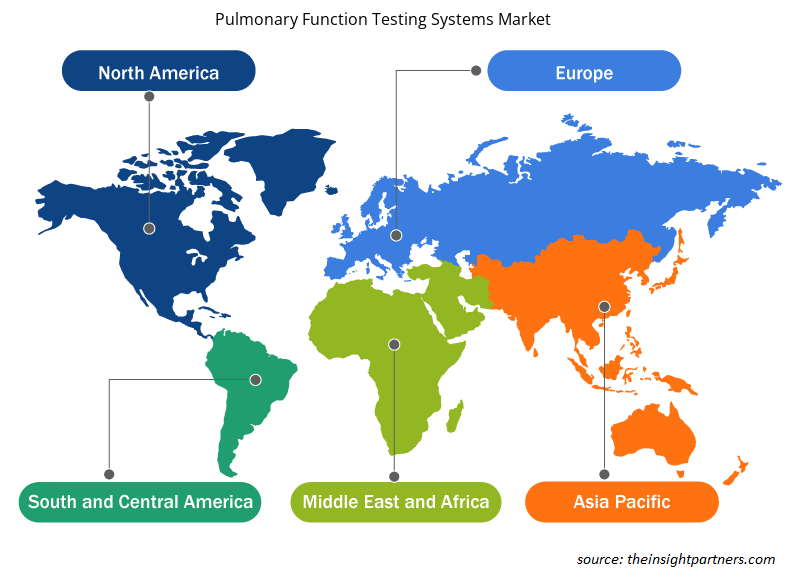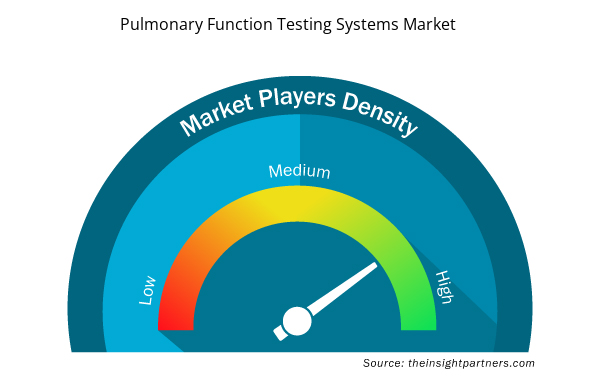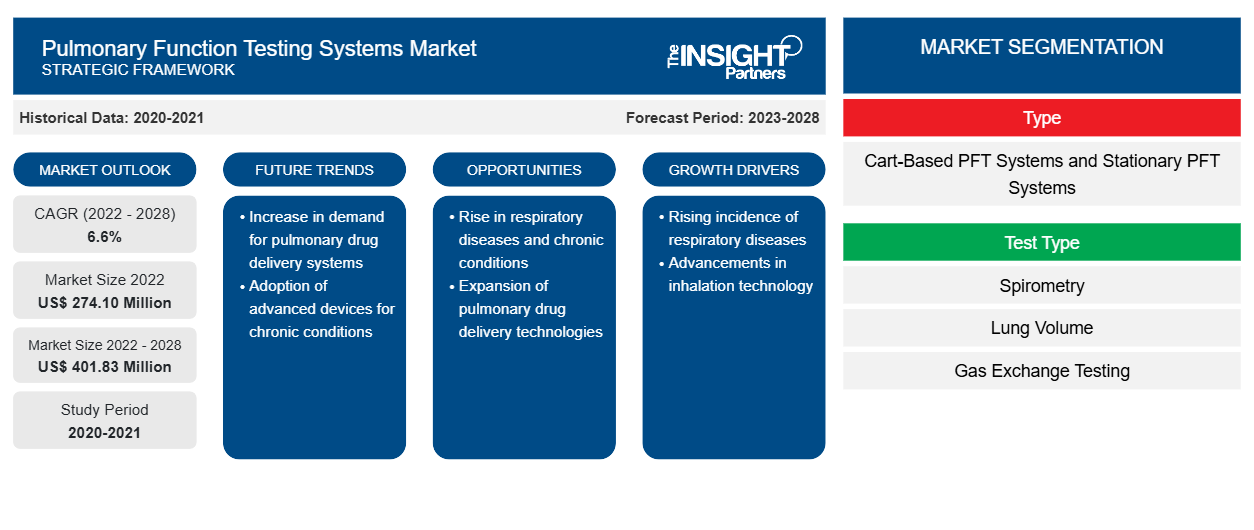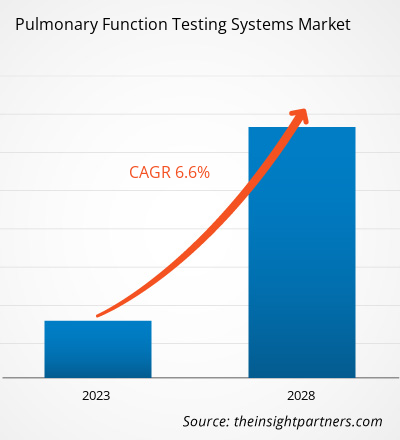Si prevede che il mercato dei sistemi di test della funzionalità polmonare raggiungerà i 401,83 milioni di dollari entro il 2028, rispetto ai 274,10 milioni di dollari del 2022. Si stima che il mercato dei sistemi di test della funzionalità polmonare registrerà un CAGR del 6,6% dal 2022 al 2028.
Il test di funzionalità polmonare (PFT) è un set di test non invasivi utilizzati per misurare il funzionamento dei polmoni di un paziente. Questi test sono importanti per diagnosticare e curare le persone con malattie respiratorie. Per eseguire i test e ottenere risultati accurati, è importante utilizzare i tipi giusti di apparecchiature e macchine PFT. Il sistema di test di funzionalità polmonare è composto da diversi dispositivi utilizzati per misurare diversi aspetti della funzionalità polmonare. Ciò può includere quanto bene i polmoni assorbono ed espellono aria, quanto efficientemente trasferiscono ossigeno al sangue e quanta aria possono contenere. I PFT misurano i volumi polmonari, le capacità e la quantità di scambio di gas. La crescente incidenza di disturbi correlati ai polmoni e malattie polmonari professionali sta contribuendo alla crescita delle dimensioni del mercato dei sistemi di test di funzionalità polmonare . Tuttavia, il rischio di contaminazione incrociata e la mancanza di professionisti qualificati stanno ostacolando la crescita del mercato.
Il mercato dei sistemi di test della funzionalità polmonare è stato segmentato in base a tipo, tipo di test, componente, applicazione, utente finale e area geografica. In termini di area geografica, il mercato è principalmente segmentato in Nord America, Europa, Asia Pacifico, Medio Oriente e Africa e Sud e Centro America. Il rapporto offre approfondimenti e analisi approfondite del mercato, sottolineando parametri quali tendenze del mercato dei sistemi di test della funzionalità polmonare, progressi tecnologici, dinamiche di mercato e analisi del panorama competitivo dei principali attori del mercato.
Personalizza questo report in base alle tue esigenze
Riceverai la personalizzazione gratuita di qualsiasi report, comprese parti di questo report, o analisi a livello nazionale, pacchetto dati Excel, oltre a usufruire di grandi offerte e sconti per start-up e università
- Scopri le principali tendenze di mercato in questo rapporto.Questo campione GRATUITO includerà analisi di dati che spaziano dalle tendenze di mercato alle stime e alle previsioni.
Approfondimenti di mercato
Aumento dell'incidenza delle malattie polmonari
Secondo il rapporto 2023 della British Lung Foundation, ogni settimana nel Regno Unito circa 10.000 persone ricevono una diagnosi di malattia polmonare. Inoltre, le malattie polmonari sono responsabili di oltre 70.000.000 di ricoveri ospedalieri, con 6 milioni di giorni di degenza ospedaliera nel Regno Unito ogni anno. Pertanto, i sistemi di test della funzionalità polmonare (PFT) si dimostrano utili nella diagnosi e nel monitoraggio. I sistemi PFT forniscono risultati accurati, in particolare volume polmonare, capacità, velocità di flusso e scambio di gas. Inoltre, l'utilizzo dei sistemi PFT aiuta a valutare il trattamento per asma, enfisema e altri problemi polmonari cronici. Attraverso la valutazione di volumi polmonari, capacità, velocità di flusso e scambio di gas, i PFT possono fornire informazioni che possono essere valutate dai medici per aiutare a diagnosticare efficacemente determinati disturbi polmonari e decidere il trattamento giusto per i pazienti. Inoltre, i PFT sono procedure non invasive e sono solitamente raccomandati dai medici per i pazienti senza degenza ospedaliera. I sistemi commerciali di test della funzionalità polmonare disponibili sul mercato includono la spirometria . Il test spirometrico è utile per determinare se il paziente soffre di una malattia polmonare, il tipo di malattia polmonare, la progressione della malattia polmonare e il deterioramento della malattia polmonare. La spirometria misura il flusso d'aria e può valutare un'ampia gamma di malattie polmonari tra i pazienti. Pertanto, la crescente incidenza di disturbi correlati ai polmoni sta alimentando l'uso di sistemi di test della funzionalità polmonare.
Informazioni basate sul tipo
In base al tipo, il mercato dei sistemi di test della funzionalità polmonare è segmentato in sistemi PFT basati su carrello e sistemi PFT fissi. Il segmento basato su carrello ha detenuto una quota maggiore del mercato nel 2022. Inoltre, si prevede che il segmento basato su carrello registrerà un CAGR più elevato nel mercato durante il periodo di previsione.
Informazioni basate sul tipo di test
In termini di tipo di test, il mercato dei sistemi di test della funzionalità polmonare è stato segmentato in spirometria, volume polmonare, test di scambio gassoso, ventilazione volontaria massima, test di titolazione dell'ossigeno e altri. Il segmento della spirometria ha detenuto la quota maggiore del mercato nel 2022. Inoltre, si prevede che il segmento del volume polmonare registrerà il CAGR più elevato nel mercato durante il periodo di previsione.
Approfondimenti basati sui componenti
In base al componente, il mercato dei sistemi di test della funzionalità polmonare è stato segmentato in hardware, software e servizi. Il segmento hardware ha detenuto la quota maggiore del mercato nel 2022. Si prevede che il segmento software registrerà il CAGR più elevato nel mercato durante il periodo di previsione.
Approfondimenti basati sulle applicazioni
In base all'applicazione, il mercato dei sistemi di test della funzionalità polmonare è stato segmentato in broncopneumopatia cronica ostruttiva (BPCO) , asma, mancanza di respiro cronica, malattie polmonari restrittive e altri. Il segmento della broncopneumopatia cronica ostruttiva (BPCO) ha detenuto la quota maggiore del mercato nel 2022. Inoltre, si prevede che lo stesso segmento registrerà il CAGR più elevato nel mercato durante il periodo di previsione.CAGR in the market during the forecast period.
Informazioni basate sull'utente finale
In base all'utente finale, il mercato dei sistemi di test della funzionalità polmonare è stato segmentato in ospedali, cliniche specialistiche e centri diagnostici. Il segmento degli ospedali ha detenuto la quota maggiore del mercato nel 2022. Si prevede che il segmento delle cliniche specialistiche registrerà il CAGR più elevato nel mercato durante il periodo di previsione.CAGR in the market during the forecast period.
Il COVID-19 è un'infezione dell'apparato respiratorio che può causare rapidamente sintomi simili alla polmonite e infezioni toraciche. Ciò può comportare un peggioramento delle condizioni di salute del paziente. I ventilatori aiutano a gestire lo scambio di gas dei pazienti. A causa dell'epidemia di COVID-19, c'era una domanda molto elevata di sistemi di test della funzionalità polmonare. L'American Lung Association e i Centers for Disease Control and Prevention hanno raccomandato che i pazienti con sintomi lievi di COVID-19 eseguano test della funzionalità polmonare per controllare la capacità polmonare del paziente. Il test della funzionalità polmonare è uno strumento ideale per valutare l'impatto fisiologico di un virus che attacca in gran parte il sistema cardiopolmonare. La tecnologia che misura il flusso d'aria, i volumi polmonari e la capacità di ossigeno e anidride carbonica di trasferirsi tra gli alveoli e il flusso sanguigno è ben consolidata e le strutture per eseguire questi test si trovano in tutti gli Stati Uniti.
Le aziende nel mercato dei sistemi di test della funzionalità polmonare adottano comunemente lanci di prodotti e strategie di espansione per espandere la propria presenza in tutto il mondo e soddisfare la crescente domanda. La loro attenzione all'innovazione di prodotto consente loro di soddisfare le mutevoli richieste dei clienti e di mantenere il proprio marchio in tutto il mondo.
- A giugno 2022, ndd Medical Technologies (ndd) ha aggiornato l'intera gamma di prodotti EasyOne, inclusi EasyOne Air, Easy on-PC, EasyOne Pro ed EasyOne Pro LAB, per renderli conformi alla standardizzazione ATS/ERS della spirometria 2019.
- Ad aprile 2021, Vyaire Medical ha annunciato il lancio europeo di ArtiQ.PFT, uno strumento automatizzato basato sull'intelligenza artificiale che interpreta istantaneamente i test di funzionalità polmonare (PFT). ArtiQ.PFT è la prima soluzione PFT basata su cloud che sfrutta l'intelligenza artificiale.
In termini geografici, il mercato globale dei sistemi di test della funzionalità polmonare è suddiviso in Nord America (Stati Uniti, Canada e Messico), Europa (Francia, Germania, Regno Unito, Spagna, Italia e resto d'Europa), Asia Pacifico (Cina, India, Giappone, Australia, Corea del Sud e resto dell'APAC), Medio Oriente e Africa (Arabia Saudita, Emirati Arabi Uniti, Sudafrica e resto dell'area MEA) e Sud e Centro America (Brasile, Argentina e resto del Sud e Centro America).APAC), the Middle East & Africa (Saudi Arabia, the UAE, South Africa, and the Rest of MEA), and South & Central America (Brazil, Argentina, and the Rest of South & Central America).
Approfondimenti regionali sul mercato dei sistemi di test della funzionalità polmonare
Le tendenze regionali e i fattori che influenzano il mercato dei sistemi di test della funzionalità polmonare durante il periodo di previsione sono stati ampiamente spiegati dagli analisti di Insight Partners. Questa sezione discute anche i segmenti di mercato dei sistemi di test della funzionalità polmonare e la geografia in Nord America, Europa, Asia Pacifico, Medio Oriente e Africa e Sud e Centro America.

- Ottieni i dati specifici regionali per il mercato dei sistemi di test della funzionalità polmonare
Ambito del rapporto di mercato sui sistemi di test della funzionalità polmonare
| Attributo del report | Dettagli |
|---|---|
| Dimensioni del mercato nel 2022 | 274,10 milioni di dollari USA |
| Dimensioni del mercato entro il 2028 | 401,83 milioni di dollari USA |
| CAGR globale (2022 - 2028) | 6,6% |
| Dati storici | 2020-2021 |
| Periodo di previsione | 2023-2028 |
| Segmenti coperti | Per tipo
|
| Regioni e Paesi coperti | America del Nord
|
| Leader di mercato e profili aziendali chiave |
|
Sistemi di test della funzionalità polmonare: densità degli attori del mercato: comprendere il suo impatto sulle dinamiche aziendali
Il mercato dei sistemi di test della funzionalità polmonare sta crescendo rapidamente, spinto dalla crescente domanda degli utenti finali dovuta a fattori quali l'evoluzione delle preferenze dei consumatori, i progressi tecnologici e una maggiore consapevolezza dei benefici del prodotto. Con l'aumento della domanda, le aziende stanno ampliando le loro offerte, innovando per soddisfare le esigenze dei consumatori e capitalizzando sulle tendenze emergenti, il che alimenta ulteriormente la crescita del mercato.
La densità degli operatori di mercato si riferisce alla distribuzione di aziende o società che operano in un particolare mercato o settore. Indica quanti concorrenti (operatori di mercato) sono presenti in un dato spazio di mercato in relazione alle sue dimensioni o al valore di mercato totale.
Le principali aziende che operano nel mercato dei sistemi di test della funzionalità polmonare sono:
- SCHILLER
- COSMED srl
- Società di diagnostica MGC
- Ganshoran Medizin elettronico
- ndd Tecnologie Mediche
Disclaimer : le aziende elencate sopra non sono classificate secondo un ordine particolare.

- Ottieni la panoramica dei principali attori del mercato dei sistemi di test della funzionalità polmonare
Profili aziendali
- COSMED Srl
- MGC Diagnostica Corpo
- Morgan Scientific Inc
- Minato Medical Science Co Ltd
- Schiller AG
- Cassa MI Inc
- Vyaire Medical Inc
- ndd Tecnologie mediche Inc
- Dispositivi medici avanzati PulmOne Ltd
- KoKo PFT Ltd
- Analisi storica (2 anni), anno base, previsione (7 anni) con CAGR
- Analisi PEST e SWOT
- Valore/volume delle dimensioni del mercato - Globale, regionale, nazionale
- Industria e panorama competitivo
- Set di dati Excel



Report Coverage
Revenue forecast, Company Analysis, Industry landscape, Growth factors, and Trends

Segment Covered
This text is related
to segments covered.

Regional Scope
North America, Europe, Asia Pacific, Middle East & Africa, South & Central America

Country Scope
This text is related
to country scope.
Domande frequenti
COSMED Srl, MGC Diagnostics Corp, Morgan Scientific Inc, Minato Medical Science Co Ltd, Schiller AG, Chest MI Inc, Vyaire Medical Inc, ndd Medical Technologies Inc, PulmOne Advanced Medical Devices Ltd, KoKo PFT Ltd, and among others are among the leading companies operating in the pulmonary function testing systems market.
Global pulmonary function testing systems market is segmented by region into North America, Europe, Asia Pacific, Middle East & Africa, and South & Central America.
Hospitals segment dominated the global pulmonary function testing systems market and accounted for the largest market share during the forecast period of 2022-2028.
Based on the application, chronic obstructive pulmonary disorder segment took the forefront leaders in the worldwide market by accounting largest share in 2021.
Based on type segment, the cart-based PFT systems segment took the forefront leaders in the worldwide market by accounting largest share in 2021 and is expected to continue to do so till the forecast period.
Rising incidence of lung-related disorders and occupational lung diseases are the most significant factors responsible for the overall market growth.
Pulmonary functioning testing (PFT) is a set of noninvasive tests that are used to measure how well a patient’s lungs are working. This is important in the diagnosis and treatment of those with respiratory diseases. In order to perform the tests and obtain accurate results, it is important to use the right types of PFT equipment and machines. There are several different devices in system. Pulmonary functioning testing system is made up of several devices that are used to measure different aspects of lung function. This can include how well the lungs take in and expel air, how efficiently they transfer oxygen to the blood, and how much air the lungs can hold. PFT’s measure lung volumes, capacities, and the amount of gas exchange.
Trends and growth analysis reports related to Life Sciences : READ MORE..
The List of Companies - Pulmonary Function Testing Systems Market
- SCHILLER
- COSMED srl
- MGC Diagnostics Corporation
- Ganshoran Medizin Electronic
- ndd Medical Technologies
- Morgan Scientific Inc.
- Pulm One Advanced Medical Devices Ltd
- CHEST M.I., Inc
- Vyaire Medical, Inc.
- Koko LLC
The Insight Partners performs research in 4 major stages: Data Collection & Secondary Research, Primary Research, Data Analysis and Data Triangulation & Final Review.
- Data Collection and Secondary Research:
As a market research and consulting firm operating from a decade, we have published and advised several client across the globe. First step for any study will start with an assessment of currently available data and insights from existing reports. Further, historical and current market information is collected from Investor Presentations, Annual Reports, SEC Filings, etc., and other information related to company’s performance and market positioning are gathered from Paid Databases (Factiva, Hoovers, and Reuters) and various other publications available in public domain.
Several associations trade associates, technical forums, institutes, societies and organization are accessed to gain technical as well as market related insights through their publications such as research papers, blogs and press releases related to the studies are referred to get cues about the market. Further, white papers, journals, magazines, and other news articles published in last 3 years are scrutinized and analyzed to understand the current market trends.
- Primary Research:
The primarily interview analysis comprise of data obtained from industry participants interview and answers to survey questions gathered by in-house primary team.
For primary research, interviews are conducted with industry experts/CEOs/Marketing Managers/VPs/Subject Matter Experts from both demand and supply side to get a 360-degree view of the market. The primary team conducts several interviews based on the complexity of the markets to understand the various market trends and dynamics which makes research more credible and precise.
A typical research interview fulfils the following functions:
- Provides first-hand information on the market size, market trends, growth trends, competitive landscape, and outlook
- Validates and strengthens in-house secondary research findings
- Develops the analysis team’s expertise and market understanding
Primary research involves email interactions and telephone interviews for each market, category, segment, and sub-segment across geographies. The participants who typically take part in such a process include, but are not limited to:
- Industry participants: VPs, business development managers, market intelligence managers and national sales managers
- Outside experts: Valuation experts, research analysts and key opinion leaders specializing in the electronics and semiconductor industry.
Below is the breakup of our primary respondents by company, designation, and region:

Once we receive the confirmation from primary research sources or primary respondents, we finalize the base year market estimation and forecast the data as per the macroeconomic and microeconomic factors assessed during data collection.
- Data Analysis:
Once data is validated through both secondary as well as primary respondents, we finalize the market estimations by hypothesis formulation and factor analysis at regional and country level.
- Macro-Economic Factor Analysis:
We analyse macroeconomic indicators such the gross domestic product (GDP), increase in the demand for goods and services across industries, technological advancement, regional economic growth, governmental policies, the influence of COVID-19, PEST analysis, and other aspects. This analysis aids in setting benchmarks for various nations/regions and approximating market splits. Additionally, the general trend of the aforementioned components aid in determining the market's development possibilities.
- Country Level Data:
Various factors that are especially aligned to the country are taken into account to determine the market size for a certain area and country, including the presence of vendors, such as headquarters and offices, the country's GDP, demand patterns, and industry growth. To comprehend the market dynamics for the nation, a number of growth variables, inhibitors, application areas, and current market trends are researched. The aforementioned elements aid in determining the country's overall market's growth potential.
- Company Profile:
The “Table of Contents” is formulated by listing and analyzing more than 25 - 30 companies operating in the market ecosystem across geographies. However, we profile only 10 companies as a standard practice in our syndicate reports. These 10 companies comprise leading, emerging, and regional players. Nonetheless, our analysis is not restricted to the 10 listed companies, we also analyze other companies present in the market to develop a holistic view and understand the prevailing trends. The “Company Profiles” section in the report covers key facts, business description, products & services, financial information, SWOT analysis, and key developments. The financial information presented is extracted from the annual reports and official documents of the publicly listed companies. Upon collecting the information for the sections of respective companies, we verify them via various primary sources and then compile the data in respective company profiles. The company level information helps us in deriving the base number as well as in forecasting the market size.
- Developing Base Number:
Aggregation of sales statistics (2020-2022) and macro-economic factor, and other secondary and primary research insights are utilized to arrive at base number and related market shares for 2022. The data gaps are identified in this step and relevant market data is analyzed, collected from paid primary interviews or databases. On finalizing the base year market size, forecasts are developed on the basis of macro-economic, industry and market growth factors and company level analysis.
- Data Triangulation and Final Review:
The market findings and base year market size calculations are validated from supply as well as demand side. Demand side validations are based on macro-economic factor analysis and benchmarks for respective regions and countries. In case of supply side validations, revenues of major companies are estimated (in case not available) based on industry benchmark, approximate number of employees, product portfolio, and primary interviews revenues are gathered. Further revenue from target product/service segment is assessed to avoid overshooting of market statistics. In case of heavy deviations between supply and demand side values, all thes steps are repeated to achieve synchronization.
We follow an iterative model, wherein we share our research findings with Subject Matter Experts (SME’s) and Key Opinion Leaders (KOLs) until consensus view of the market is not formulated – this model negates any drastic deviation in the opinions of experts. Only validated and universally acceptable research findings are quoted in our reports.
We have important check points that we use to validate our research findings – which we call – data triangulation, where we validate the information, we generate from secondary sources with primary interviews and then we re-validate with our internal data bases and Subject matter experts. This comprehensive model enables us to deliver high quality, reliable data in shortest possible time.


 Ottieni un campione gratuito per questo repot
Ottieni un campione gratuito per questo repot